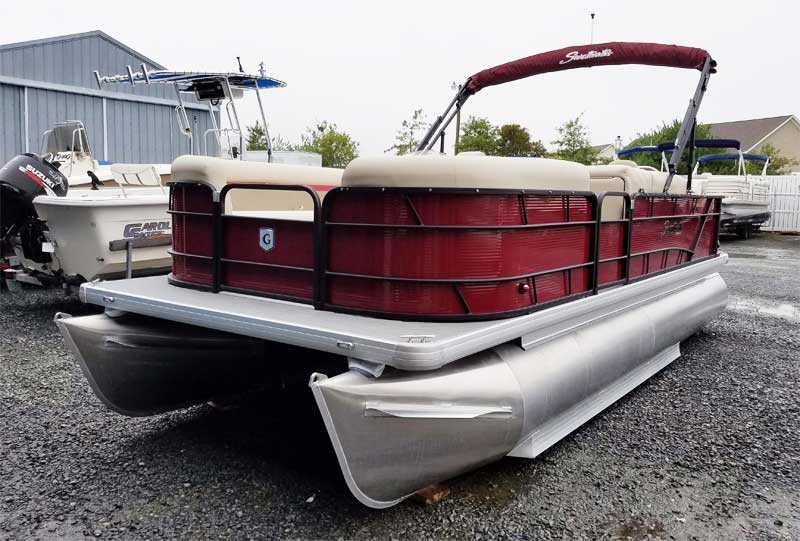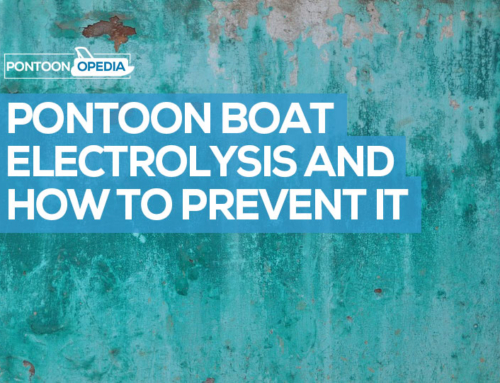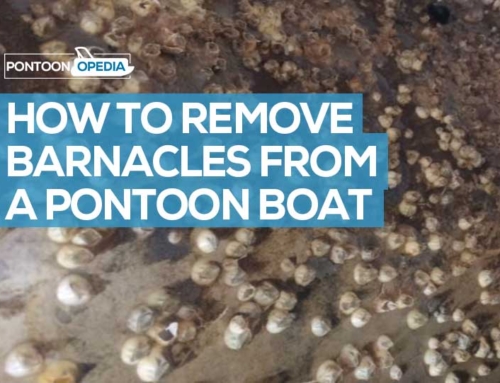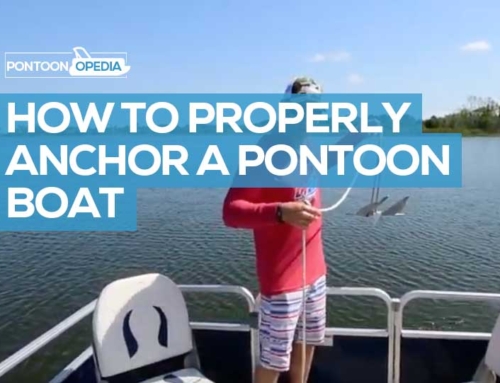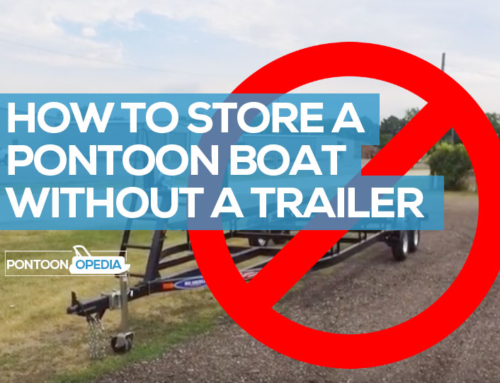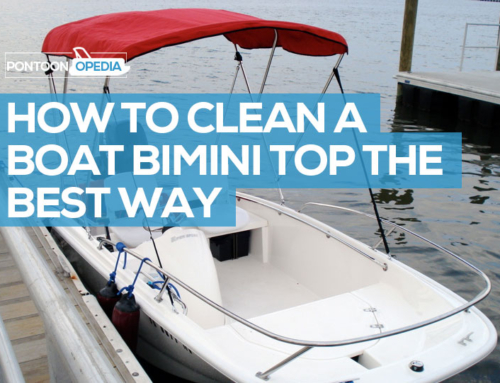Pontoons, or toons for those in the know, are perfect craft for local lakes and waterways, they generally have a lot more space deck side for those long relaxing days on the water. Pontoon boats can be anything from a wooden deck roped to a few 50-gallon drums powered by the current, to a sleek modern boat with aluminium pontoons and a powerful engine.
Now for the average pontoon owner reading this article it is likely you are somewhere in the middle and own a standard pontoon boat with a modest motor.
It is also likely that you want to know whether taking the time to under-skin your pontoon boat is something actually worth doing or not.
Below I will show you how you can under-skin your own pontoon boat to help reduce drag, water splash, and even possibly eke out a little bit more speed when out on the water.
What is Under-Skinning?
For the uninitiated, under skinning is the process of adding an aluminium sheet to the underside of your boat. It has a few benefits such as:
- Under-skin can help to reduce drag
- Under-skin can help to cut down on water spray
- Under-skin can make a slighter faster and smoother ride
- Under-skin can protect the bottom of your pontoon from debris damage
Under-skinning your pontoon boat will help to prevent the water from shooting up from the sides of the pontoons and colliding into the cross members. These cross members can either be wooden or aluminium depending on the boat.
When the boat reaches high speeds, the water shoots up from the inner side of the pontoons and crashes into the cross beams. As a result, some of the pontoon boat’s energy is lost.
This effect can even cause the toon to angle slightly forward at higher speeds. By adding an under-skin to enclose these beams you are creating a smoother low friction path for the water, thus winning a couple of horsepower too.
Comparing Under Skin Types for Pontoon Boats: Benefits and Drawbacks
Under skinning a pontoon boat can improve its performance, reduce drag, and protect the boat’s structure from debris and water damage. There are various types of under skin materials available, each with its unique benefits and drawbacks. This section compares the most common materials, aluminum and polyurethane foam, to help pontoon boat owners choose the best option for their needs.
Aluminum Under Skin
Aluminum is a popular choice for under skinning pontoon boats due to its durability, lightweight nature, and corrosion resistance.
- Benefits: Aluminum under skin provides a strong and rigid surface that can withstand impact from debris and resist water damage. It is also relatively low-maintenance, requiring little upkeep to maintain its integrity. Furthermore, the lightweight nature of aluminum minimizes added weight to the boat, ensuring that performance is not negatively affected.
- Drawbacks: Aluminum under skin can be more expensive than other materials, making it a less budget-friendly option. Additionally, while aluminum is corrosion-resistant, it may still require periodic treatment to maintain its protective properties, especially in saltwater environments.
Polyurethane Foam Under Skin
Polyurethane foam is another common choice for under skinning pontoon boats, known for its insulating properties and affordability.
- Benefits: Polyurethane foam is lightweight, easy to install, and provides an effective barrier against water and debris. Its insulating properties can help to dampen noise and vibrations, resulting in a quieter and more comfortable ride. Polyurethane foam is also a more affordable option compared to aluminum, making it an attractive choice for those on a tighter budget.
- Drawbacks: While polyurethane foam offers adequate protection and insulation, it may not be as durable as aluminum, potentially requiring more frequent replacement or repairs. Additionally, it can be susceptible to damage from UV exposure, so proper maintenance and care are essential to ensure its longevity.
What You Will Need & How to Do It
Firstly, lets discuss a few material options, I recommend that a marine grade aluminium be the only material on your radar as you don’t want to lose any hard-won horsepower by adding a heavy material like steel or wood to your boat.
You want to keep the plate as thin as possible to reduce weight, therefore a thickness of 0.065″ is ideal.
This will provide a good balance between strength and weight.
Next, you will need fasteners to fix the aluminium sheet to your cross beams. The material of the fastener is extremely important as two incompatible materials in a wet environment can create some interesting electrochemical reactions that will ultimately result in your under-skin landing underwater.
Any type of low carbon steel is definitely a no go as this will corrode in the first week.
Furthermore, aluminium fasteners are simply just not strong enough. I would recommend stainless steel self-tapping screws with marine grade rubber washers.
If you are operating your toon in saltwater (unlikely), then it is extremely important to spend a little extra money on the correct materials.
Aluminium Sheeting Options
There are two ways to add aluminium sheeting to the underside of your boat. The most logical is to have one large plate cut to size.
This is normally quite simple to do at any metal working shop as they just throw the sheet into a guillotine.
I would advise you to have the sheet cut so that there are 1/2″ gaps next to the pontoons. This will allow any water to drain out easily. You don’t want water accumulating between the skin and the deck.
Having one sheet also means that you will have no seams where the water can get caught up on and leak through.
The only problems you might encounter would be if you have a relatively large area to cover. If that’s the case, then you will need some extra hands to make the work easier. If your boat is too large, finding a single sheet might actually be impossible.
If you want to go down the route of using multiple smaller sheets, then I would advise that you start adding the sheet sections from the rear. Then as you add the next sheet, overlap the previous one by about 2 inches.
Continue to do this until you get to the front of the boat. By taking this approach, you will ensure that the sheets are arranged in a scaled configuration, reducing any friction.
Make sure that you plan the sheet sizes so that the overlaps are at a cross beam.
If you are using a thin sheet of aluminium and your cross beam spacing is relatively large, then you will run the risk of the plate sagging in places.
To eliminate this, add a few spacers lengthwise between the crossbeams so that there is space to insert the self-tapping screws.
These spacers can be made of wood or aluminium and can be screwed onto the cross beams with angle brackets.
Fastening the Sheet
If I plan on adding lots of fasteners to sheeting I always work out the spacing beforehand and drill small pilot holes into the sheet before trying to mount it.
If you don’t feel like drilling, then a center punch will also do the trick.
If you are working from underneath your pontoon boat to add under-skinning, then this will save you a huge amount of frustration caused by slipping screws. Believe me, it’s a pain, and it’s something that I always manage to do.
Use a cordless drill with a socket head to drive the self-tapping screws into the cross beams, and don’t forget to add the washer before inserting the self-tapping screw.
You don’t want to re-screw a self-tapper into a soft material like aluminium as you will run the risk of stripping the threads the second time around. Beware of over tightening! Always.
Before you know it, you will have a pontoon boat with a beautiful under-skin that provides some extra power and has the added benefit of protecting the underside of your boat from floating debris and other obstacles.

